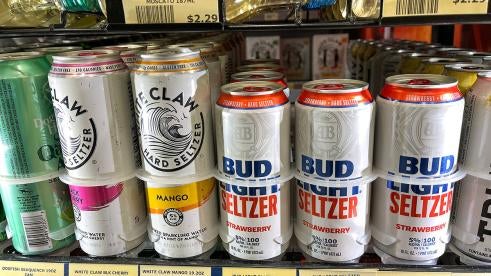In its recent decision made 22 September 2021, in case T-195/20 Sociedade de Àgua de Monchique v EUIPO, the GCEU settled a longtime quarrel regarding the similarity between waters, and by extension non-alcoholic beverages, in Class 32 and alcoholic beverages in Class 33 in the European Union.
In 2017, a Portuguese company filed an EU trademark application for the figurative sign for “non-alcoholic beverages; bottled drinking water; mineral water (non-medicated); mineral water [beverages]” in Class 32.
An opposition was filed based on the earlier registration of “CHIC BARCELONA” and the “alcoholic beverages (except beer); wine; sparkling wines; liqueurs; spirits [beverages]; brandy” designated in Class 33 on the ground that the similarity existing between the signs and the goods at issue generated a likelihood of confusion amongst the public.
The opposition division of the EUIPO upheld the opposition regarding the “non-alcoholic beverages” (Class 32), considering that the latter goods were similar to a low degree to the “alcoholic beverages (except beer),” but rejected the opposition regarding the rest of the goods.
Unhappy with this half-hearted decision, the opponent filed an appeal with the Boards of Appeal, which sided with the opponent, stating, “‘bottled drinking water; mineral water (non-medicated); mineral water [beverages]’ were also similar, to a low degree, [to] ‘alcoholic beverages.’”
The applicant lodged an appeal before the GCEU that overturned the Boards of Appeal’s decision and held that the goods of Classes 32 and 33 at issue were not similar (even to a low degree) but actually dissimilar considering, in substance, that:
-
Because of the absence of alcohol in their composition, waters differ in nature to alcoholic beverages covered by the earlier mark (the effects of alcohol consumption)
-
The purpose and method of use of the goods in question are different (waters meet a vital need)
-
The goods are not complementary because the one who buys waters is not obligated to purchase alcoholic beverages and vice versa
-
The goods are not in competition with each other (not substitutable)
-
In regard to the distribution channels, the fact that the goods can be sold in the same facilities does not mean that they must be regarded as similar.
Accordingly, the GCEU ruled out any likelihood of confusion between the marks.
Ideally, this decision would put an end to the uncertainty of the EU jurisprudence, which has ruled in both directions over the years. However, nothing is certain. Will the GCEU and the EUIPO have the same position for all kinds of non-alcoholic beverages? If this is the case for fruit juices, nothing is certain for alcohol-free wines and beers, which are closer to alcoholic beverages in terms of pricing, taste, purpose and consumption time. For instance, the National Institute of Industrial Property in France, which consistently rules that non-alcoholic beverages and alcoholic beverages are dissimilar, considers that non-alcoholic aperitifs are similar to alcoholic beverages.





 i
i


